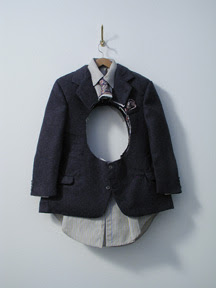
workworkworkworkwork is a retrospective exhibition that brings together numerous bodies of work by New York artist Charles LeDray. Master miniaturist, LeDray, has spent the last two decades creating an arsenal of intricately crafted, everyday objects on a very small scale. The title of the show refers to an earlier project. In 1991, after creating a trove of handmade miniature items like clothing, magazines, books and many other household items, LeDray displayed the work on a Manhattan sidewalk. He presented the items randomly, like someone’s possessions in a sidewalk sale. The work on view at the Whitney Museum also includes hand-stitched clothing, paperback books, and daily objects, as well as wheel-thrown tiny ceramics and meticulously carved human bone sculptures such as buttons or furniture. The featurepresentation of the exhibition is the artist’s most recent work, Men’s Suits, (2006-2009), an installation of three vignettes of second hand shops.
Upon entry into the exhibition the viewer confronts Village People (2003-2006), little hats of all kinds lining the length of the wall, high above eye level. All kinds of hats in miniature are represented such as the sombrero, cowboy, safari, or Indian headdress. These hats obviously refer to the different roles we play in our lives. Our identities become presented through such roles, developed through our professions, interests, or responsibilities.
Not all, but most, of LeDray’s works are experiments with men’s clothing. Lining the gallery walls are miniature outfits, suits, and uniforms, tailored to perfection. But this is not a fashion show. Surprisingly, LeDray never had formal training. He learned to sew from his mother as a child. The work he creates is scaled down, perhaps so the objects are not mistaken for commodities, but, instead, are subjects for introspection. The clothing we wear is the way inwhich we present and protect ourselves in the world. These works serve as substitutes for human presence, almost breathing on their own. Clothes that have been through life do not stay pristine. LeDray’s articles of clothing show such signs of life as tatters, stains, holes, missing buttons, and patched denim. Much of the work is quite literal, while other clothes are wittily or humorously abstracted or altered.

The series Men’s Suits (2006-2009), is a presentation of three small-scale scenes of second-hand clothing shops. One scene presents what looks like the back room of a store with hangers, laundry bags, a ladder and piles of clothes in disarray. The second is a public second hand or vintage shop, fully stocked, with coats, jackets, pants, shirts, gloves, belts and more. The third is a specialty section of a men’s shop, featuring an array of tiny ties, each a different pattern, from paisley to plaid. For this project LeDray spent three years painstakingly hand sewing miniature suits, shirts, and accessories, as well as crafting furniture, clothes hangers, laundry bags and shopping carts. The work is astounding in its realism. The miniature adult clothes are small - too small for any real person to wear - but they are not so small to seem like toys. The fabrics are not cheap and flimsy like doll’s clothes. One can tell that the materials have been carefully chosen, cut from real clothes. Small and wonderful, the work is delightful, but not necessarily cute. Blue jeans and jackets look worn, as if real life had been carried out in them. The vignettes are startlingly believable, causing a suspension of disbelief. One wonders about the lives of people who might have worn these clothes or who might choose to purchase them. This sensation is reminiscent of visiting preserved historical places, such as Versailles, Monticello, or the Anne Frank house, as they manage to transport the viewer to the environment and give a realistic sense of the lives that were lived there. This sensation, however, is momentary. The viewer is not completely enveloped, but towers above the scenes. One quickly returns to reality and the vignettes begin to feel like oversized dioramas.

Wonder and disbelief are heightened when viewing Charles LeDray’s intricate ceramics. Presented in 6-7 ft. tall multi-tiered vitrines Throwing Shadows and Milk and Honey show thousands of delicate, porcelain vessels. The shapes of the vessels vary greatly and no form is spared. There are amphoras, urns, decanters, carafes, jugs, bowls, etc. One wonders what these tiny containers hold. Are they vessels for the hopes and dreams of the living or little reliquaries for something lost?

No comments:
Post a Comment